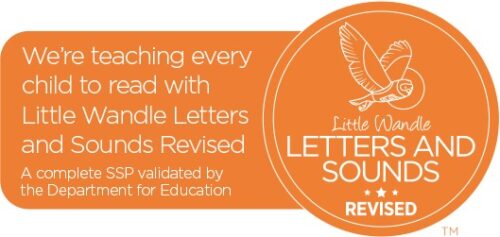Early Reading and Phonics
Systematic synthetic phonics is taught daily in EYFS and KS1 and is prioritised as the most important strategy in teaching our early readers the skills, strategies and knowledge needed to succeed, with the ambition that every child is a reader by age 7. We follow the Little Wandle programme, based on the original Letters and Sounds, but extensively revised to provide a complete teaching programme meeting all the expectations of the National Curriculum and preparing our children to flourish beyond the expectations of the Phonics Screening Check in Year 1.
In all areas of our phonics teaching, we employ the seven key features that have been identified through the English Hubs programme as characterising highly successful phonics teaching:
• direct teaching in frequent, short bursts
• consistency of approach
• secure, systematic progression in phonics learning
• maintaining pace of learning
• providing repeated practice
• application of phonics using matched decodable books
• early identification of children at risk of falling behind, linked to the provision of effective keep-up support.
Through the vehicle of our chosen phonics programme, Little Wandle, we ensure that children learn the necessary grapheme-phoneme correspondences (GPCs) to read new and familiar words and then apply this knowledge to sentence level reading. Following phonics lessons, which entail revision and teaching of new GPCs, children practise segmenting words into known individual phonemes and then blending them to read the words in new and familiar books. In order to build confidence and ensure success in reading, children are given decodable books that only contain the taught sounds from prior phonics sessions. We share decodable books – physically and virtually – with parents at home to bring our families into our reading community and ensure success for our young readers.
Rigorous, regular assessment is employed to identify children who need additional support to ‘keep-up’. Early readers in Year 2 and KS2 receive rigorous daily intervention with the same phonics pedagogy to accelerate learning and equip them with the skills to become lifelong readers.
Please view our Phonics Early Reading Policy 2022
Please view our Reading Progression document.
Please view our Phonics Resources Spring 2023
Click here to access Little Wandle Phonics eBooks
KS2
We use aspects of the Destination Reader model which is an approach to teaching reading which can be applied to all texts. It focuses on:
Key reading strategies which support comprehension
Learning behaviours which support dialogue
It involves daily sessions incorporating whole class modelling prior to the children applying these skills through partner work and independent reading. Children deepen their understanding of the texts they read through the systematic use of a series of strategies and language stems. The approach encompasses the key principles of effective reading provision and fully meets the requirements of the National Curriculum. It also builds a culture of reading for pleasure and purpose.
Intent:
To provide clear, consistent structure for daily reading lessons
To enable children to become successful readers and comprehenders through the explicit teaching of key strategies
To ensure engagement though an interactive approach, fostering reading for pleasure and purpose
To provide a structured approach to key learning behaviours which allow children to be fully independent learners
Reading for Pleasure
Our priority is both the teaching of reading skills and the enjoyment of literature, enabling children to become lifelong, confident readers. To help promote reading for pleasure, we run the Camden Reading Road Map. 10 roads in Camden represent a specific genre of books: Adventure; Classics; Crime; Fantasy; Graphic Novels; Horror; Humour; Poetry; Sci-Fi and Sport. The author and title of each book in each genre are listed along each appropriate road. On the back of the map are the sections listing the books relating to each genre. To the left of each book title is a coloured circle – we used a traffic light system for identifying less challenging, challenging and more challenging books. To the right of the title we have a small blank circle, which is ticked by the teacher when the book has been read by each child. The Road Map contains 60 books in 10 different genres. It allows children to start reading whatever they like and encourages them to try out different titles, genres and authors, get out of their ‘comfort zone’, to find new writers to enjoy, and to get into the habit of ‘dipping into’ different genres. Ultimately, children are reading more; they have a large number of well-curated new fiction made explicitly available to them and love a bit of competition to get closer to completing the map!

